#Viking Honour
Explore tagged Tumblr posts
Text
Highland Park 12 Years Old Viking Honour
Highland Park 12 Years Old Viking Honour Single Malt Scotch Whisky #review
Highland Park 12 Years Old Viking Honour Single Malt Scotch Whisky Image courtesy of Master of Malt 1. What they say Matured predominantly in European and American sherry seasoned oak casks, our iconic 12 Year Old single malt whisky is spicy and well-rounded, packed with the flavours of sun-kissed Seville oranges and rich fruitcake spiced with cinnamon, nutmeg and cloves; you’ll find molten…

View On WordPress
#12 Years Old#40% ABV#£30#Highland Park#Highland park distillery#ingle malt#Island#OB#Scotch#Sherry Cask#Viking Honour#Whisky
0 notes
Text








FEMALE AWESOME MEME | (3/10) Queens ~ Emma of Normandy (Vikings: Valhalla)
I arrived in this county as a 15 year old girl, who could not speak the language and was a piece of property. I am now the queen of an expanding empire, and a wealthy woman in my own right. If you think that I'm incapable of taking care of both, my husband's interest and my own, you do so at your own peril.
#vikings: valhalla#vikingsvalhallaedit#vikingsedit#perioddramaedit#emma of normandy#Laura Berlin#S1E04 The Bridge#S2E01 The Web of Fate#S2E05 Birth and Rebirth#S2E08 The Reckoning#S3E01 Seven Years Later#S3E02 Honour and Dishonour#S3E07 Hardrada#S3E08 Destinies#vvs1#vvs2#vvs3#fameme#my edits
172 notes
·
View notes
Text
"you're exaggerating how much people misremember, people are just reporting the version of the film before the final twist" THEY'RE NOT THOUGH.
loki did (pretend to) plan to let laufey kill odin, that's true. but it was NEVER "confirmed" that loki considered himself more jotun than asgardian, or that he intended to help jotunheim "take over" asgard. when loki is making his deal with laufey, he's actually playing the part of an arrogant, reckless asgardian prince, (in fact, more or less, of thor). he doesn't tell anyone of his newly discovered heritage, he is condescending and presumptuous, and he insults jotunheim to laufey's face. and yet people CONSISTENTLY misremember this as loki taking jotunheim's side, not even as a trick but as the whole of his plan.
and this is because it's not just about what they actually saw in the film, it's about them filling in the blanks for a generic high fantasy plot, and part of that generic plot is the total opposition of Evil Monsters and their Evil King with the Good King and his Rightful Throne. the generic fantasy plot being invoked and subverted does not allow for the possibility of an asgardian being the ultimate villain, and so people remember loki's motives and values as un-asgardian and anti-asgardian, even though they're actually the most asgardian thing imaginable.
#space viking tag#meta#ch: loki#th: manipulation + mind control#th: honour + villainy#th: monsterhood
42 notes
·
View notes
Note
Do you think Uhtred was as in love with Alfred as Alfred was with him?
HELLO!! okay, i think that they loved (and despised) each other in equal measure, though the actual difference that should be considered with them is more about who showed it more between the two of them than whether or not they had the same amount of love for each other, and for that it's also important to consider that how much someone shows the love doesn't automatically imply that one loved the former more than the latter.
so if we consider the question as a "who was more willing to show that love" then i would argue that it was actually uhtred who did that more, but that's completely because he was more open to it compared to alfred who had wayyyy more to lose and wayyyy more issues with loving a man than uhtred ever did (for example, uhtred's openness with aethelstan's homosexuality in seven kings must die).
NOW, my brain is pretty dead so i don't know how to explain it any better, but i think i talked more about all of this in detail on this previous post!! xx
#thank you for asking tho!!#i genuinely don't know how to answer#but pretty much i think that they loved each other just as much#also i don't wanna say that uhtred would have had no issues with it#since the honour thing was something very much present in a viking society#but compared to alfred he had less problems and uhtred was also way more reckless than alfred was#especially when he was younger#and i could also argue that supporting someone (uhtred supporting aethelstan) and accepting it for yourself can also be 2 different things#so uhtred could have had a different reaction for himself#but still i think alfred had more issues in general for sure and more to lose as well#ANYWAY YEAH THOSE ARE PRETTY MUCH MY THOUGHTS ON THE MATTER AGAHAHAHAHA#the last kingdom#alfred x uhtred#alhtred#uhtred x alfred#tlk alfred#uhtred#asks#also on the post i shared the link of i remember dividing it in two so the first part is about alfred and the second is about uhtred#there's like a space in between so you can go directly to uhtred's part!!
10 notes
·
View notes
Text
tagged by @lesbosexual to do my top 9 films i first watched in 2024!









these are in the order i watched them - Laura in March, Dunc Part Tunc in April, The Exorcist and Collateral in June, Harakiri in July, Eyes of Laura Mars in August, I Saw The TV Glow in September, Heathers in October, and Puss in Boots: The Last Wish a couple of weeks ago
ISTTVG is the most a film has impacted me, possibly ever. It hurt. It still hurts, I feel like it's a film I need to revisit and rewatch at some point, but even three months on I'm not sure I'm quite ready yet.
Harakiri, Laura, The Exorcist, and Puss in Boots were all films that I knew I'd love, or that I'd just heard so much about in terms of them being near-perfect films that it was not surprising at all that they're favourites of mine now too. Likewise Dunc, though that had only been out for a few months when I saw it at the student cinema.
Laura was picked on a whim by my mother and honestly it's done me a disservice for every other Noir I watch, because it's such a perfectly constructed film that everything else I've seen in the genre doesn't seem anywhere near as good.
Collateral was one Charlie had mentioned, and she was absolutely right that it's exactly my thing and a fucking fantastic film. Similar in some ways to Ghost Dog: Way of the Samurai in what I have started referring to as "philosophical crime dramas," giving just as much time to their protagonist's understanding of the universe and their place in it as they give to tense action or chase sequences.
Eyes of Laura Mars was a strange one, because about halfway through I found myself tiring of it a little, and said that one choice it made was the most boring way the story could have gone, unless something very specific happened at the end. And then at the very end, that thing did happen, and my perspective on the entire film flipped and it's solidly one of my favourite films of all time, which I didn't expect when I picked it out semi-randomly due to a vaguely interesting premise and it being in a collection on Criterion.
I shall tag: @grimdarknokia @regicidal-defenestration @lycheo @ylfas-bottleneck @innocet @zagreus-eats-your-bread and anyone else who would like to do this!
#HONOURABLE MENTIONS#favourite barbie film i saw: mariposa#favourite short film: opera no. 1#favourite dr who serial i discovered this year: either frontios snakedance or the hand of fear#worst film: the saga of the viking women and their voyage to the waters of the great north sea serpent#most middling film: wonka#the only two new releases i saw in cinemas when they first came out was the new pota and the new wallace and gromit
5 notes
·
View notes
Text
So. Vinland saga s2 ost came out yesterday. And right at the very start of the album, I can already tell that this album really came for my tearducts
#Vinland saga#Vinland saga s2#They really started with Somewhere not here and I bawled my eyes out#Episode 23 second half really was my personal highlight of the season#I love LOVE canute and thorfinns reunion and the i have no enemies scene#But nothing can beat the visual and musical power of seeing the cast change for the better#And leading a more honest life of wanting to create and better themselves and their lives#Away from the Viking lifestyle#And also can we talk about how somewhere not here also has aspects of Arnheids theme#Fitting because this track plays when thorfinn and Einar promised to make a better world in her honour too#I read the manga of this part as reference. And they didn't have the carve it poem as they showed everyone in ketils farm#The anime really heightened the experience#It was so powerful. To see how hard they were working and then the swelling music#And the poem that on the first episode#Meant carnage and violence. In episode 23 it talks about creating change. And making a mark so powerful that it impacts everyone around you#And that shit made me bawl so much it was too powerful#Goodness I am not normal about vinland saga please someone talk to me about it
14 notes
·
View notes
Text
The Long Night: A Fantasy Adventure of Courage & Betrayal | Free Audio Story | Audiobook
🏹 Embark on a thrilling journey with “The Long Night,” a gripping fantasy short story that combines action, suspense, and a touch of humour. Perfect for young adults and adults alike, this tale will immerse you in a Viking-inspired fantasy world where courage and loyalty are tested. �� Story Overview:“The Long Night” follows the adventures of Ragnar and Kest, young warriors-in-training, as they…

View On WordPress
#Action-packed narrative#Adventure fiction#Character-driven plot#Coming-of-age tale#Courage in adversity#Epic fantasy fiction#fantasy battles#Fantasy for young adults#fantasy literature#Fantasy short story#Fantasy suspense#fantasy world#Honour in fantasy#Humour in fantasy#Loyalty and betrayal#Redemption themes#Rite of passage story#The Long Night#Viking fantasy#young adult fantasy
1 note
·
View note
Photo
You know you are messed up when even Rollo is standing there staring like 😐




I really forgot how much crackhead shit was in s2
46 notes
·
View notes
Text
᛬ ᚾᛁᚢ ᛫ ᚴᛅᚠᚴᚢ ᛫ ᛏᚢᚴᚦᛁᚱᚾᛅᚱ ᛬✨
Níu Gǫfgu Dygðirnar
(The Nine Noble Virtues in Old Norse)
ᛅᚱᛅᚦᛁ Áræði (Courage)
ᛋᛅᚾᛚᛅᛁᚴᛦ Sannleikr (Truth)
ᚼᛅᛁᚦᛦ Heiðr (Honour)
ᛏᚱᚢᛚᛅᛁᚴᛦ Trúleikr (Fidelity)
ᛅᚴᛁ Agi (Discipline)
ᛒᛅᛁᚾᛁ Beini (Hospitality)
ᛋᛁᛅᛚᚠᛋᛏᛅᚦᛁ Sjálfstæði (Self-reliance)
ᛁᚦᛁᚢᛋᛁᛘᛁ Iðjusemi (Industriousness)
ᚦᚱᛅᛚᛅᛁᚴᛦ þráleikr (Perseverance)

#theninenoblevirtues#ásatrú#old norse#the nine noble virtues#odinism#asatru#code of Honour#vikings#Heathen#haithnu#haithno
0 notes
Text
Based on this. You are in Finland full of self-loathing and the 141 needs a fat wife if they want to win some beer.
You aren't exactly on holiday in Finland. It should be your honeymoon but since you caught your groom balls deep in your maid of honour you instead have used it as an escape from the country. You just cannot be around the people you love right now, can't have them all look at you with all that pity. Even worse is that some of them probably don't even blame him. Your former best friend is a size 8, perfect hourglass figure. Your former partner is trim and decently fit. They look like they belong together more than you and him ever did.
You hate yourself. You hate looking in the mirror. You hate how clothes fit you. You deserved it you think.
"Not a chance MacTavish, that's my wife!"
"Away and biel yer heid, I saw her first!"
"Actually I saw her first!"
"I outrank all of you muppets so I think you'll find that is my wife!"
It's a racket in the little cafe but you don't pay much mind, still just staring out the window and wondering if you could ever deserve anything. One of the servers comes to take your empty cup and grins at you, telling you in her heavy accent that she would personally go for the one with the mask since he's the biggest. You don't understand when you look around and there are a lot of locals smiling happily over at you while four Greek Gods of men are having a scuffle, moving slowly in your direction. More people chip in, arguing about who you should pick, some lamenting that they would claim you themselves if they thought they could.
One big man does try, basically some Viking God, but he's playfully (you hope it's playful) spear tackled by the man with the mohawk before he laughs and backs off.
When Gaz with warmed cheeks and excitement in his eyes gets to you while Soap is busy with the viking and Ghost and Price are wrestling one another he asks if you'd do him the honour of being his wife. You nearly choke, but he explains that the wife carrying competition is today. You look around, bewildered, ask him why he wouldn't pick any of the other women in here given that they are all gorgeous slim things.
"Fuck all use to us, need a nice soft bird with lots of fat" says the man in the mask.
Price scowls and whacks his lieutenant upside the head because he sees how you look a second away from crying.
"You're gorgeous sweetheart, he didn't mean anything by it. The prize is the wife's weight in beer though, so he's right about a little lady not being much use."
You don't know what to say. You don't know if this is mortifying or not given that everyone around you seems to not be looking at you with sneers or laughing at you, but instead looking with soft smiles that convey fondness. They think this is adorable.
"Dinnae listen tae their nice soft birds and sweethearts! I'll be a better husband bonnie. I'm shorter aye bit look at the power in these legs, naw going tae drop ye. And I'll split that beer 50/50!"
And then they're arguing. The four of them are arguing and trying to put forward a case to you about why they would be the best husband. When it starts to get raunchy, you fluster and stop them. But fluster is something. It's not self loathing. It's been weeks since you felt anything but self loathing. So even though you are sure everyone can feel the heat rolling off of you in waves at how bashful you are under so much attention from such attractive men, you pick one (the others are devastated but vow that you're only a wife for the competition, that after they should get another shot at convincing you that they're the best option).
And they do. Even though the man you picked doesn't win (gets DQ'd actually since you are heavy and he decided that you were getting over that damn finish line so the four of them took turns) they take you out for drinks after. You think you feel humiliated that they couldn't carry you a long distance, but you don't have time to sit with the feeling because they drown it out with how warm and giddy they make you feel.
They insist that they will compete next year, so you have 365 days to pick a husband. When you make a quiet comment about how you'll lose weight by then so they can carry you the whole way, they nearly riot as they assure you that they would be a shit pick for husband if they didn't spent the year getting stronger so they can carry you just how you are. Plus they'll not be losing any beer thank you very much.
By the time the next wife carrying competition rolls around you are a different person. You're wearing clothes that fit instead of trying to hide your body. You laugh and flirt back with the barista instead of assuming they are making fun of you by flirting. And you don't care if your husband makes it over the finish line, just that you have fun and laugh and joke about the attempt. Of course it's not entirely certain who that husband is yet, got to keep them on their toes after all.
#mhairidrabbles#your annual trip to Finland just becomes you lounging while many big beefy men beg for you to be their wife for the day#if you saw the earlier version shh it was annoying me that there was no context for what was under the read more because of the screenshot#mhairiwrites
454 notes
·
View notes
Text
Venus Dominant Themes — 𝐍𝐚𝐤𝐬𝐡𝐚𝐭𝐫𝐚 𝐎𝐛𝐬𝐞𝐫𝐯𝐚𝐭𝐢𝐨𝐧 𝐒𝐞𝐫𝐢𝐞𝐬 (part 1) 𝐨𝐟 𝐩𝐚𝐫𝐭 𝟒
warnings: mentions of sexual assault, rape and murder.
Finally, I am exploring Venus as a nakshatra lord but, more importantly, the significance of the nakshatra Purva Ashada through medias I've collected. The nakshatras within the Sagittarius section seem to all connect through the theme of purification, especially with the start of Mula who destroys the falsehood through the hunter/huntress archetype and purifies the untamable. As Mula is the cycle of conquering the wild things and seeking truth, Purva Ashada is now a stage above that.

It is already evident in that Purva Ashada literally means "the undefeated" or "the unconquered", now dealing with themes of justice, honour and battle. This nakshatra is known as the Invincible Star. This victorious warrior-like essence stretches towards Uttara Ashada, as Uttara Ashada means "later victory" or "final victory", closing off this journey in Sagittarius. Other Venus nakshatras will be mentioned, as expected, since trine nakshatras all literally have the same outlining experiences.
Purva Ashada is associated with invincibility and triumph over adversity. It possesses the Varchagrahan Shakti, which is the power to invigorate or energise, meaning to be relentless and driven in its pursuit of ideals. Its desire is said to be “gaining the sea upon wishing for it”, being supported by its Jupiter rulership. As Jupiter is idealistic, Purva Ashada will be more set in its way through action and fixed determination as it is, first and foremost, a fire sign. As this is Sagittarius, it comes as no surprise that fictional archers in the media can be often played by these natives, signifying their grit and focused determination ♐︎.

Mula Suns Kathryn Winnick in Vikings and Anna Popplewell in Narnia.

Purva Ashada Moon Hailee Stainfield and Purva Ashada Sun Jeremy Renner in Hawkeye.
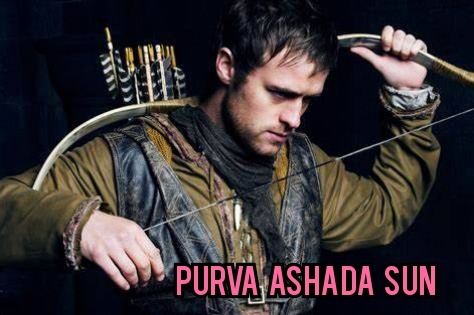
Purva Ashada Sun Jonas Armstrong in Robin Hood.
Archery is especially perfect for this nakshatra's lord as it requires a flowing adaptability and accuracy as Venus would obsess over perfecting and executing it, unyielding a level of concentration and precision through burning passion and drive.

Bharani Sun Stephen Amell in Green Arrow.
The star of Purva Ashada is very fierce and severe by nature, being Ugra, and with its Venus rulership, it will always always find a way to achieve its goals. Venus allows for creativity, craftiness, and even strategy (especially within diplomacy); the fire element making it fierce and quick-thinking for battle and war. The fire signs in the Venus section are specifically suited for overpowering societal norms in a way that their combined fire element and Venusian qualities know how to. The best character that exemplifies this is literally Mulan.

The themes of fighting for honour, family, one's country and being part of a larger purpose are just knocking on the 9H, and Sagittarius, as a whole. Purva Ashada cannot be victorious without overcoming hardships and obstacles that sharpen their skills and instincts. Her obstacle is what supports her journey to independence and truth, as she disguises herself as a man to join the army when women are not meant to fight for their country. Jupiter, being expansive in nature, shows in her decision to break free from the confines of being a traditional woman. Her character immediately signifies Sagittarius' need for freedom in pursuit of truth and expansion. When she is told no, she goes the other way to march to the beat of her own drum, her determination unwavering and her creativity helping her remain disguised while she acquires skills and knowledge that she wouldn't have as a woman (now her Jupiterian nature is able to flourish).

Purva Ashada Moon Ming-Na Wen voices Mulan. Purva Ashadha is formed by the stars Kaus Borealis and Kaus Australis in the Archer’s bow.
Purva Ashada signifies perseverance and moral duty which we see in Mulan who carries a deep responsibility to her family & country, choosing to prioritize duty and honour over societal norms or even personal desire.

She grows stronger, more skillful, after every challenge; influence of Venus sharpening and refining her, as she is on her way to become an invincible, victorious force.

Jupiter rashis (Sagittarius and Pisces) all have a theme of transcendence; Mulan's arc having more to do with family and patriotism, transcending limitations and becoming a hero who saves China. The message of the story has a lot to do with self-worth, making your mark no matter the restrictions of society; the philosophy of Mulan being that real honour and strength come from within and not from conforming.

The whole Sagittarius section deals with issues of conformity, such as Mula who doesn't fit in society or doesn't feel free within it due to its raw nature. Mula, being Ketu, tends to find ways to escape or its power can be intense. While Purva Ashada, being Venus, is more creative in maneuvering restrictions in order to overcome them.

Both Lea Salonga and Christina Aguilera sing the popular soundtrack song Reflection.
In the kdrama The King's Affection, Purva Phalguni Sun Park Eun-bin plays a character who disguises herself as a man to survive in such a patriarchal society.

Much like Mulan, she breaks societal expectations. Both characters have to prove their worth even while they're men, and these two Venusians excel in their roles despite all challenges and danger. While Mulan sacrifices her personal safety to protect her father and to fight for her country, the character Dam-i (in The King's Affection) sacrifices her identity and freedom to maintain her family's honour and stability in the kingdom.

Purva Phalguni Moon Yifei Liu in Mulan (2020)
Venus is connected to the idea of sacrifice in the willingness to endure for love, beauty, and unity. This willingness to transcend one's own personhood for the greater good or a higher ideal perfectly captures the Jupiter & Venus rulership of this nakshatra.

The film Wonder Woman (2017) begins by telling a similar arc to Mulan. Before being known as the hero named Wonder Woman, she was Diana, princess of the Amazons, who trained rigorously to be an unconquerable warrior.

Raised on a sheltered island paradise, she meets a stranded war pilot who tells her about the massive conflict happening in the outside world. Convinced that she can help stop the threat, Diana desires to leave Themyscira for the first time ever. Much like Mulan's desire to join the army was protested against, the Amazons tried to stop Diana from leaving, as they feared for her safety. As the rashi rulership here is Mars, there are no barriers to overcome to expand oneself from clear oppressive forces (which would be a Jupiterian storyline), instead, this portrayal of Wonder Woman goes head first into battle (very Aries of her).

Her Aries nature shows as we follow her in her journey of self-discovery when she joins the pilot to fight the wars. This Aries version of Wonder Woman is seen as she explores this new world like a newborn baby, as Aries is the baby of the zodiac. Her identity (following 1H themes) is slowly uncovered as she comes to realize that she is the Godkiller, meaning that she has always been a goddess. And that there is a potential confrontation awaiting her with Ares, the God of War. This discovery is picked up when she is fighting alongside men in a war to end all wars.

Bharani is ruled by the Lord Yama who is the god of justice. He oversees the transition of souls after death, ensuring that they face the consequences of their actions as he acts as a guardian of moral order and spiritual integrity.

Bharani ASC Cate Blanchett plays Hela, the Goddess of Death. Yama is the God of Death and the Lord of the Afterlife.
Purva Ashada nakshatra generally carries this sense of justice as well, as it stands for truth and high morality. This can be seen in the film North Country, which is directed by Purva Ashada Moon native Niki Caro (who also directed 2020's live-action Mulan).

Purva Phalguni ASC Charlize Theron portrays one of the members of the first group of women working at a local iron mine in Minnesota. Male workers become offended that they have to work with women, and they express this by lashing out at them, subjecting them to sexual harassment. Appalled by the physical abuse and violent misogyny, Charlize Theron's character files a historic sexual harassment lawsuit, despite being cautioned against it by family and friends.
The reality of femicide tends to be bravely explored through the media by Venusians the most, I've noticed. Acts that harm women, such as physical or sexual violence, can be seen as affronts to Venus itself, violating the sacred feminine.

A lot of revenge stories led by women start with the woman being sexually violated or physically oppressed, justifying her rage and her violence against those who have harmed her.

Lord Yama is also known as Dharma Raja, which translates to "King of Righteousness". Being associated with his punishment for sinners, retribution and justice are synonymous in this cycle; seen in popular revenge movies where one is given this divine right to properly, and quickly, execute justice for themselves and, or their loved ones. As if Lord Yama is acting through them, they are protected on their path of vengeance and restoration.

Purva Phalguni ASC Charlize Theron as Furiosa.
In the film Mad Max: Fury Road, Furiosa is driven by a desire to restore freedom, dignity, and hope to the oppressed class of society. Through her actions, she opposes the extreme patriarchy, her character signifying collective salvation. Furiosa carries a relentless drive to overthrow Immortan Joe’s tyrannical rule and rescue the few women in the society, who are treated as his property. Her unbreakable spirit in the face of extreme challenges mirrors the invincibility found within Purva Ashada (and its trine nakshatras). Purva Ashada's link to water, as it is ruled by the deity Apah, highlights purification, healing, and renewal. Furiosa’s quest to find the Green Place, a sanctuary of life and hope, reflects this thirst for a pure, life-sustaining environment. (As everywhere else is a post-apocalyptic wasteland).

Being that she is played by a Venus-nakshatra native, we see just how self-sacrificing she is for a greater purpose, being protective over the Wives and willing to risk everything for their safety and make it to the Green Place in order to establish a new foundation of harmony (Purva Phalguni is associated with comfort and happiness, and this version of Furiosa carries hope for such a future for her and the Wives).
Bharani ASC Anya Taylor Joy portrays a younger Furiosa who disguises herself as a man for survival and avenges the brutal death of her mother who was murdered in front of her as a child (much like O-Ren Ishii in Kill Bill.)

Bharani Moon Quentin Tarantino has written and directed popular revenge movies, such as Kill Bill & Django Unchained.
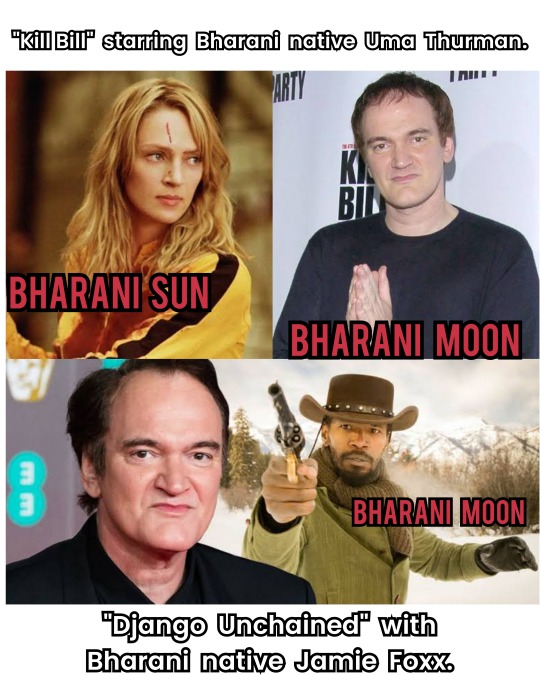
Both films star Bharani natives who execute retribution to people who did them wrong.
In Kill Bill, there's another Bharani storyline in which a little girl, O-Ren Ishii, witnesses the brutal death of her parents. She grows up to be trained and lethal, and kills the culprit that she's sworn revenge on.

O-Ren Ishii is portrayed by Bharani Moon Lucy Liu.
Bharani Moon Han So-Hee portrays Ji-woo, a woman driven by a thirst for vengeance, infiltrating a drug cartel to uncover the truth behind her father's murder.
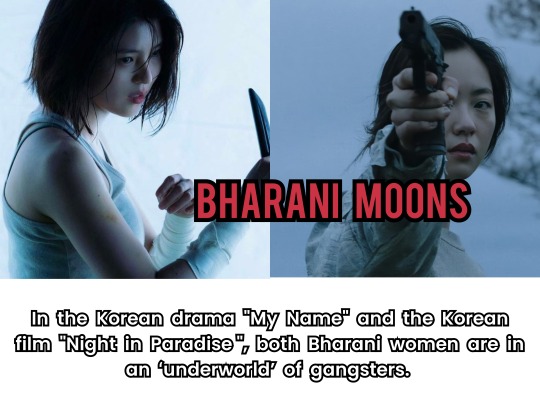
In the Korean film Night in Paradise, Bharani Moon Jeon Yeo-Been portrays a character who goes on a murder spree in the ending, ambushing the gangsters who murdered her uncle and a friend of hers and being the one to successfully kill off the antagonist.
In Last Night in Soho, Bharani ASC Anya Taylor Joy kills all the men who have sexually violated her, and more importantly, avenges herself by murdering the man who lured her into the abusive underworld.

Claire Nakti touches on Bharani women being erotic dancers and finding themselves in the underworld. This further validated Anya Taylor Joy's Bharani placement for me, in this movie she's been sex trafficked and forced to be a dancer and prostitute in an underworld of sorts.

Purva Phalguni Sun& ASC Salma Hayek as an erotic dancer in an underworld in From Dusk Till Dawn.
It is interesting as trine nakshatras are also seen associated with the Goddess Persephone, Queen of the Underworld.

In The Matrix franchise, Persephone is married to the Merovingian, a program often described as a ruler or trafficker of information in the Matrix's underworld.
The Goddess Persephone is mostly associated with Bharani nakshatra. Initially being a victim of Hades' abduction, Persephone's evolution into a strong ruler of the underworld represents resilience and empowerment which perfectly encapsulates the journey of Venus nakshatras. She literally grows into a powerful queen, presiding over the dead and representing justice and the necessary order within the underworld. Bharani signifies the womb, representing creation, struggle, and the emergence of new life. Persephone’s cyclic movement between the underworld and the earth (as she is also the personification of vegetation, also being the goddess of spring) mirrors this cycle of life, embodying death (winter) and rebirth (spring). Purva Ashada represents the regenerative power of life, also signifying its association with Persephone’s role in seasonal changes. (Also, Furiosa's abduction from the Green Place perfectly parallels Persephone's abduction, as explained above).
In conclusion, there lies a higher purpose within the Venus nakshatras, especially Purva Ashada nakshatra, which possesses an ability to harmonize life's dualities—victory and loss, pleasure and pain, creation and destruction, love and retribution—into a transformative journey of growth, empowerment, and universal balance. Venus emphasizes how resilience and renewal can lead to profound evolution, with Purva Ashada's process of purification being removing impurities and starting anew. The character Mulan going through army training highlighted her inadequacies and shortcomings; her initiation of purification being the stage where she breaks free from traditional expectations. And so the process of purification is seen in her discovering ways to make up for her lack of physical strength, this being a mark of her transformation while being disguised as a man. Rediscovering her inner strength is all the cleansing of self-doubt that she needs to go through to finally be in her final triumph. Reconciling her inner self with her external role, Mulan symbolizes the renewal and balance within Purva Ashada.
#purva ashada#sagitarrius#purva phalguni#leo#bharani#aries#venus#venus nakshatras#jupiter#sun#vedic astrology#sidereal astrology#astrology#sidereal observations#vedic observations#mula#vedic astro observations#vedic astro notes#sidereal sagittarius#nakshatra series
360 notes
·
View notes
Text








FEMALE AWESOME MEME | (2/10) Mother Characters ~ Ælfgifu of Northampton (Vikings: Valhalla)
Surly, you are astute enough to realize that if a wolf is roaming your halls and warming itself by your fires, it must be considering you its dinner.
#vikings: valhalla#vikingsedit#perioddramaedit#vikingsvalhallaedit#Queen Ælfgifu#Ælfgifu of Northampton#Pollyanna McIntosh#aelfgifu of northampton#queen aelfgifu#S1E08 The End of the Beginning#S2E01 The Web of Fate#S2E08 The Reckoning#S3E02 Honour and Dishonour#S3E07 Hardrada#S3E6 Return to Kattegat#vvs1#vvs2#vvs3#fameme#my edits
79 notes
·
View notes
Text
but the thing is you really DON'T let your characters use phrasing like "knee-deep in blood" about a character we're meant to trust unquestioningly. you don't let antagonists call a genuinely noble and peace-loving king "a murderer and a thief" unless you're going to disprove it somehow; you certainly don't have them say that to a prince who is explicitly imitating his father, and explicitly his worst and darkest self as a result. you don't build your entire movie around a heroic son redeeming himself from imitation of his father and a villainous son corrupting himself through imitation of his father if that father is meant to be aspirational. you don't hinge your whole movie on the twist that your villain's motive is loyalty to the king unless loyalty to the king is itself morally questionable.
it's honestly very easy to tell a morally straightforward story. the fantasy genre does it all the time. but, despite surface-level appearances, thor chooses not to do so at every turn.
#I'M NOT CRAZY#space viking tag#meta#ch: odin#th: mind control + manipulation#th: honour + villainy#th: cycles + scapegoats#s: t1
11 notes
·
View notes
Text
THE HOT MEDIEVAL & FANTASY MEN MELEE
SECOND ROUND: 26th Tilt
Jareth, the Goblin King, Labyrinth (1986) VS. Edgin Darvis, Dungeons & Dragons: Honour Among Thieves (2023)


Propaganda
Jareth, the Goblin King, Labyrinth (1986) Portrayed by: David Bowie Defeated Opponents: - Jafar [Marwan Kenzari], Aladdin (2019) - Ivar the Boneless [Alex Høgh Andersen], Vikings (2013)
“Are those tights family friendly? Definitely not. Was Jareth the sexual awakening of more people than I can count! Obviously, it's David Bowie in a leather jacket/feather cape/poets shirt/etc what more could you ask for. He's sexy, he's ambiguous, he's powerful but he will bow to you. He's symbolic of growing up and also the Goblin King who will feed you poison fruit if it means he's got a shot at winning. The fics are legion and for good reason. "Fear me, love me, do as I say, and I will be your slave" rewrote my brain.”
Edgin Darvis, Dungeons & Dragons: Honour Among Thieves (2023) Portrayed by: Chris Pine Defeated Opponents: - Cinderella’s Prince [Chris Pine], Into the Woods (2012) - Wat [Alan Tudyk], A Knight’s Tale (2001)
“Edgin is such a fun character - he's charismatic, realistically flawed, and genuinely kind to the people around him. His platonic relationship with Holga is delightful. And he's pretty - he's not a strong warrior or hardened veteran, but a handsome guy with a good smile.”
Additional Propaganda Under the Cut
Additional Propaganda
For Jareth:







For Edgin Darvis:
“I like...his face. And his lute. And his ability to value friendships with women.”



“He's a clever charismatic thief, he's funny, he's tough, he's devoted to his daughter. He's a gorgeous DILF.”
[Gifset]

#medieval hotties round 2#jareth#jareth the goblin king#edgin darvis#labyrinth#dungeons & dragons#honor among thieves#david bowie#chris pine#fuck that medieval man
154 notes
·
View notes
Text





LAURA BERLIN as Queen Emma of Normandy Vikings: Valhalla, Honour and Dishonour (3.02)
#vikingsedit#vikingsvalhallaedit#perioddramaedit#gifshistorical#valhallacentral#lauraberlinedit#laura berlin gifs#emma of normandy#laura berlin#vikings valhalla#vikings valhalla spoilers#tvedit#netflixedit#*gifs#*mine#n:300
325 notes
·
View notes
Text
Every Pagan Holiday

JANUARY
KALENDS
1st January
Origins: Ancient Greece/Rome
Observed by: Hellenic/Roman polytheists
Honouring Janus/Juno, first day of the Year. Kalends brought us the word 'calendar'.
ÞORRABLÓT (THORRABLÓT)
End of January/beginning of February
Origins: Iceland
Observed by: Heathens, Asatru
Midwinter Festival honouring Thor, usually by feasting and poetry.

FEBRUARY
IMBOLC
2nd February
Origins: Celtic polytheism /Ireland, as St. Brigid's Day
Observed by: Most neopagans, Wiccans, Druids, Asatru (as Charming of the Plow)
Imbolc is the most widely known and observed pagan holiday in the months of January and February. It falls at the beginning of spring/end of the winter for the Celtic peoples; marking the changing of the seasons, as most holidays do. St. Brigid is a Christianised form of or inspired by the Celtic fertility goddess Brigid who is celebrated on this day.
PARENTALIA
13th-21st February
Origins: Ancient Rome
Observed by: Greco-Roman polytheists
Translating to 'Ancestors Day', Parentalia is a nine-day celebration of deceased ancestors. Historically it was observed by feasting and making offerings and sacrifices to the dead and spirits of the underworld.
VÁLI'S BLOT
14th February
Origins: Old Norse
Observed by: Heathens, Asatru, Norse polytheists
Váli's Blot is considered by some Asatru to be the Norse equivalent of Valentine's Day but is widely acknowledged as a season changing festival. A day for marriage and celebrating with family and friends, and for remembrance of Váli, the son of Odin who defeated Höðr on this day.
LUPERCALIA
15th February
Origins: Ancient Rome
Observed by: Greco-Roman polytheists
Festival thought to honour a wolf who raised abandoned princes, celebrated originally by sacrificing goats to the gods, feasting, and, for fertility, nudity and fornication.
LESSER ELEUSINIAN MYSTERIES
17th-23rd February
Origins: Ancient Greece
Observed by: Hellenic polytheists
Initiation to the cult of Persephone and Demeter by sacrificing a pig. Prelude to Greater Mysteries, initiations held on these dates. Once completed, initiates could then move onto Greater Mysteries in the autumn.
ANTHESTERIA
27th February - 1st March 2021
Origins: Ancient Greece
Observed by: Hellenic polytheists
Athenian festivals dedicated to Dionysus and the dead. Held around the full moon in the month of Anthesterion, which in the Gregorian calendar this year roughly translates to 27th February.
THE DISTING/DÍSABLÓT
End of February/beginning of March
Origins: Uppsala, Sweden
Observed by: Heathens, Asatru, Norse polytheists
Celebration of Valkyries and other female spirits, called dísir. Sacrifices were made for a good harvest. Celebrated still by an annual market in Sweden.
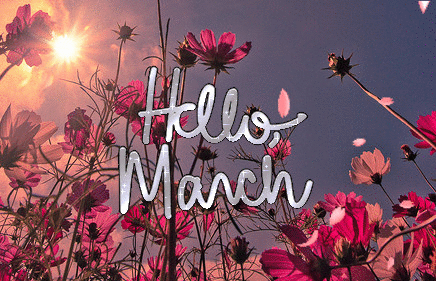
MARCH
KALENDS
1st March
Origins: Ancient Greece/Rome
Observed by: Hellenic/Roman polytheists
Honouring the god Mars/Ares. Kalends brought us the word 'calendar'.
OSTARA/EARRACH
20th March
Origins: Anglo Saxon paganism, popularised as Ostara by Wicca
Observed by: Anglo Saxon Pagans, Wiccans, Neopagans, Druids (as Alba Eilir), Heathens (as Summer Finding), Ásatrú (as Sigrblót)
The northern hemisphere's vernal equinox, the word Ostara was introduced though Wicca and named for the goddess Eostre. Surprisingly unrelated to Easter in all but name, Ostara symbolises the beginning of spring. As a seasonal holiday it is widely celebrated by many different groups of pagans.
RAGNAR LODBROK'S DAY
28th March
Origins: Icelandic Sagas
Observed by: Ásatrú
Day of remembrance for Ragnar Lodbrok, Viking King of legend

APRIL
KALENDS/VENERALIA
1st April
Origins: Ancient Greece/Rome
Observed by: Hellenic/Roman polytheists
Celebration of the first of the month, this one honouring the goddess, Venus.
REMEMBRANCE FOR HAAKON SIGURDSSON
9th April
Origins: Norway, C9th
Observed by: Ásatrú
Day of remembrance for ruler of Norway who claimed lineage to Odin in the Icelandic Sagas.
WALPURGISNACHT
30th April
Origins: German Christianity, originally Saint Walpurga was known for banishing witches and other pests
Observed by: LaVeyan Satanists
Anton LaVey chose to celebrate this holiday as a follow up to the spring equinox and due to its past association with witchcraft.
HEXENNACHT (WITCHES' NIGHT)
30th April
Origins: German folklore, as Walpurgisnacht but witches were alleged to convene with the devil in this night
Observed by: Temple of Satan as 'a solemn holiday to honour those who were victimized by superstition'.

MAY
BEALTAINE/BELTANE
1st May
Origins: Celtic (Ireland/Scotland/Isle of Man)
Observed by: Wiccans, Neopagans, Celtic reconstructionist, Ásatrú/Heathens (as May Day)
One of the more well-known pagan festivals, Beltane is a festival of fire and the beginning of the summer. Also widely referred to as May Day, it is celebrated by lighting fires.
KALENDS
1st May
Origins: Ancient Greece/Rome
Observed by: Hellenic/Roman polytheists
Honouring the goddess Maia, for whom the month may have been named.
REMEMBRANCE FOR Guðröðr of Guðbrandsdál
9th May
Origins: C11 Norway, Icelandic Sagas
Observed by: Ásatrú, Norse, heathens
Guðröðr had his tongue removed by Óláfr for rebelling against violent conversion from Norse paganism to Christianity.

JUNE
KALENDS
1st June
Origins: Ancient Greece/Rome
Observed by: Hellenic/Roman polytheists
Anniversary of temples to Juno Moneta (protectress of money, her temple was where coins were made), Mars/Ares (God of war), and the Tempestates (goddesses of storms).
ARRHEPHORIA
3rd Skirophorion (translates to mid-June)
Origins: Ancient Greece
Observed by: Hellenic reconstructionist
Feast in celebration of Athena and fertility.
MIDSUMMER/SUMMER SOLSTICE
21st June
Origins: Agricultural holiday/longest day observed for centuries by many civilisations. Christianity can date to as early as C4th
Observed by: Wiccans/Germanic neopagans (as Litha), Asatru/Heathens, Druids (as Alban Hefin)
One of the main four holidays in the Wheel of the Year and popularised by Wiccans and neopagans as Litha which is taken from the Anglo-Saxon words for June/July, this is the longest day of the year and the middle point and sometimes considered the beginning of summer.

JULY
REMEMBRANCE FOR UNNR/AUD THE DEEP MINDED
9th July
Origins: C9th Iceland
Observed by: Ásatrú, Heathens, Norse reconstructionist
Aud was a traveller in the 9th century moving between Dublin, the Hebrides, Orkney, and finally Iceland following the deaths of her husband and son. This day is to honour her memory.
HERACLEIA
July/August
Origins: Ancient Greece
Observed by: Hellenic polytheists
Festival dedicated to Heracles the demigod and his death, involving feasting and celebration.

AUGUST
LUGHNASADH/LAMMAS
1st August
Origins: Celtic Britain (Ireland, Scotland, Isle of Man)
Observed by: Wiccans, Neopagans, Christians (as Lammas), Ásatrú (as Freyfaxi)
Named for the god Lugh, this festival is one of the Celtic harvest festivals and marks the beginning of the harvesting months. It was celebrated by climbing mountains, bull sacrifice, offerings, and feasting. Handfasting is commonplace with Wiccans in modern times.
REMEMBRANCE FOR REDBAD, KING OF THE FRISIANS
9th August
Origins: C7th Frisia (area of Germany/Netherlands)
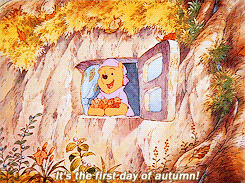
SEPTEMBER
NOUMENIA
8th September
Origins: Ancient Greece
Observed by: Hellenic polytheists
Celebration of new Hellenic lunar month. Offerings of honey and incense made to household deities.
REMEMBRANCE FOR HERMANN THE CHERUSCAN
9th September
Origins: C9th CE
Observed by: Heathens, Ásatrú
Hermann the Cheruscan, also known as Arminius of the Cherusci tribe, led the defeat against the Romans at the Battle of Teutoburg Forest and is lauded for saving Eastern Germanic peoples from being conquered by the Roman Empire.
AUTUMN EQUINOX (NORTHERN HEMISPHERE)
22nd September
Origins: 1970s neopaganism
Observed by: Wiccans and Neopagans (as Mabon), Ásatrú (as Winter Finding)
Named Mabon by prominent Wicca and Neopagan Aidan Kelly, after the Welsh mythological figure Mabon ap Moldron, the autumn equinox is one of the harvest festivals and marks the beginning of autumn in the northern hemisphere. Mabon is a relatively new pagan holiday not based on any specific historical festival, but traditionally people around the world would celebrate some kind of harvest festival around the end of September/beginning of October.
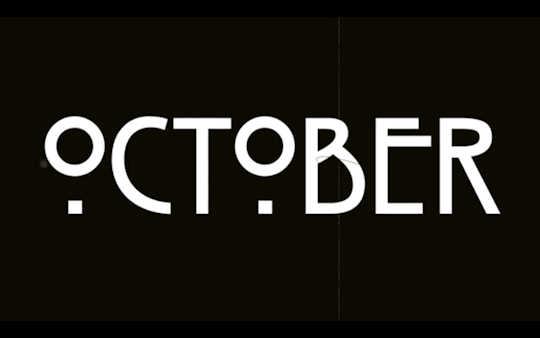
OCTOBER
PYANOPSIA
7th October
Origins: Ancient Greece
Observed by: Hellenic polytheists
Pyanopsia, or Pyanepsia, is a festival to honour Apollo, one of the most important deities, God of music, the sun, knowledge, healing, and archery - amongst other things. During the festival, two special offerings would be placed on doorways and carried to the temple. These offerings were a bean stew, and an olive branch wrapped in wool with honeys, pastries and seasonal fruits hanging from it.
REMEMBRANCE FOR LEIF EIRIKSSON
9th October
Origins: C10th CE
Observed by: Heathens, Ásatrú, Norse pagans
Remembrance for Leif and his sister Freydís Eiríksdóttir, children of Erik the Red, who are cited with being the first Norse explorers in North America.
THESMOPHORIA
12th-14th October
Origins: Ancient Greece
Observed by: Hellenic polytheists
Festival held in honour of Demeter Thesmophoros, goddess of agriculture, and her daughter Persephone, goddess of death and life, Queen of the Underworld. Celebrated primarily by women, this festival is linked with fertility, and we know very little about it due to its secretive rites. It is thought that it involved the sacrifice of pigs (although some sources say women), and abstinence.
REMEMBRANCE FOR ERIK THE RED
28th October
Origins: C9th CE
Observed by: Heathens, Ásatrú, Norse pagans
Erik the Red, probably named for the colour of his hair and beard, was the first permanent European settler in Greenland. His children were explorers too, who went to America, and although his wife converted to Christianity, Erik remained faithful to his Norse pagan gods.
SAMHAIN (HALLOWE'EN)
31st October-1st November
Origins: Gaelic - Scotland, Ireland, Isle of Man
Observed by: Celtic pagans, Neopagans, Wiccans
Pronounced SOW-in (sow rhyming with cow), Samhain was originally a harvest festival marking the beginning of winter. The day itself is the 1st November, but celebrations begin on October 31st, and this has become the accepted associated day. It's a festival of the dead, where the síthe, fae and spirits, can enter this realm from their own. Wiccans talk of a 'veil' thinning, meaning the boundary between worlds. Similar death related festivals around this time can be noted in other faiths from across the globe, and of course in the modern Hallowe'en.
WINTER NIGHTS (VETRNAETR), ÁLFABLÓT/DÍSABLÓT
31st October
Origins:
Celebrated by: Heathens, Ásatrú, Norse pagans
Winter Nights is mentioned in the Ynglinga Saga as one of the three greatest blessings of the year, the other two being Sigrblót in April, and þorrablót in late Jan/early Feb. Winter Nights is the celebration of the beginning of the winter season; Álfablót is a sacrifice to the elves, and Dísablót a sacrifice to the female spirits (dísir) and Valkyries.

NOVEMBER
REMEMBRANCE FOR SIGRID THE HAUGHTY
9th November
Origins: C9th CE
Observed by: Heathens, Ásatrú, Norse pagans
It is not actually known whether Sigrid Storråda, or Sigrid the Haughty, was an actual historical figure, an amalgamation of a few, or simply a myth. The lore goes that she was proposed to multiple times and turned down many but went on to orchestrate conflict when a potential suitor - Olaf Tryggvason, King of Norway - attempted to convert her to Christianity.

DECEMBER
REMEMBRANCE FOR EGILL SKALLAGRÍMSSON
9th December
Origins: C10th CE
Observed by: Heathens, Ásatrú, Norse pagans
Day celebrating the poet, farmer, and berserker Egill Skallagrímsson, who is recalled in The Icelandic Sagas by Snorri Sturluson. Egill is known for his many killings and escaping death by writing an epic poem after being captured when washing up on our Northumberland coastline.
SATURNALIA
17th - 23rd December
Origins: Ancient Rome
Observed by: Roman polytheists, some Hellenic
Like Yule and Lesser Dionysia, Saturnalia was the Roman winter festival celebrating the coming return of the sun and honouring the god Saturn. The standard feasting and drinking feature, and slaves would be treated as equals like Dionysia. Saturnalia is another festival cited as being picked up by Christians and used as inspiration for Christmas.
WINTER SOLSTICE (YULE/MIDWINTER)
21st December
Origins: Germanic nations, as early as C4th CE
Observed by: Norse pagans, Wiccans, Neopagans, LaVeyan Satanists, Ásatrú, Heathens, many Germanic nonpagan peoples
Yule is the midwinter festival known commonly among pagans as a time for feasting, being with loved ones, remembering ancestors, and looking forward to the return of the light and warmer days. Many pagans will celebrate Yule for more than one day, some celebrating a week either side, some for longer, up to two months, and some for twelve days afterwards. True Yule would have originally been in January for midwinter, but King Haakon the Good
moved it to coincide with the Christian celebrations in the 10th century, as told in the Ynglinga Saga.
On the 24th of December, Anglo Saxons are said to have celebrated 'Mothers Night' honouring female ancestors.
RURAL/LESSER DIONYSIA
End of December/beginning of January
Origins: Ancient Greece
Observed by: Hellenic polytheists
Smaller festival honouring the god Dionysus (Greater Dionysia took place in cities at the end of winter). Feasting, mask wearing to stop distinction between classes so that everyone could feel equal, sacrifices, parades, and phallic display were all used to celebrate.
#wheel of the year#wiccan#pagan#heathen#greek#mythology#holidays#religious holidays#pagan holidays#non-Abrahamic holidays#witch#witchcraft#witchblr#pagan wicca#polytheism#paganism#witches#witch holidays#witches holidays#pagan witch
284 notes
·
View notes